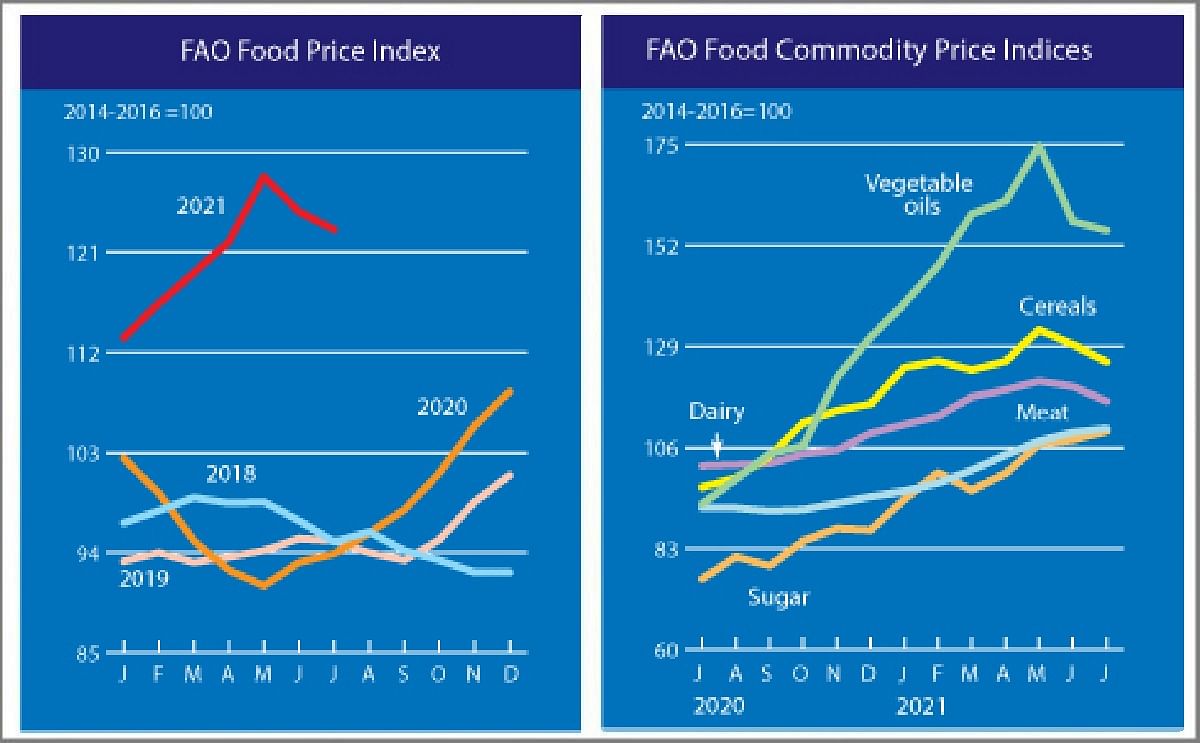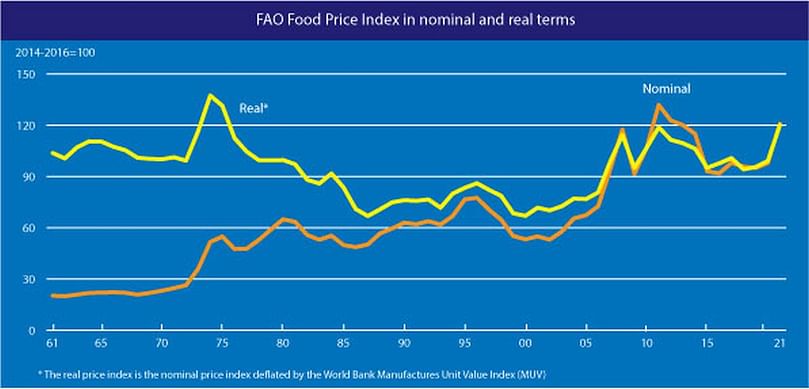The FAO Food Price Index fell again in July
Primaire tabs
The FAO Food Price Index fell again in July

The FAO Food Price Index (FFPI) averaged 123.0 points in July 2021, down 1.5 points (1.2 percent) from June but still 29.1 points (31.0 percent) higher than its level in the same period last year.
The drop in July reflected declines in prices of cereals, dairy products and vegetable oils which more than offset increases in meat and sugar quotations for the second consecutive month.
The FAO Cereal Price Index averaged 125.5 points in July, down 3.8 points (3.0 percent) from June but still 28.6 points (29.6 percent) above its July 2020 value.
International maize prices fell by 9.1 points (6.0 percent) month-on-month on better yields than earlier projected in Argentina and improved production prospects in the United States of America.
Cancelled orders of old crop maize by China also weighed on maize quotations.
However, prices received some support from continued crop condition concerns in Brazil, where threshing progressed well behind last year’s pace and high domestic prices encouraged farmers to direct sales to domestic markets.
Barley and sorghum export prices also fell in July, by 8.3 points (6.4 percent) and 8.7 points (5.3 percent), respectively, mostly reflecting weaker import demand.
By contrast, wheat quotations edged upwards in July, rising by 2.2 points (1.8 percent) to their highest level since mid-2014, driven by continued concerns over crop conditions in North America where persistent dryness hindered yields of durum wheat in Canada and spring wheat in the United States of America.
Conversely, heavy rain threatened crop prospects in parts of Europe, while early yields in the Russian Federation were slightly lower than expected. In the southern hemisphere, production outlooks remained favourable in Argentina and Australia.
International rice prices accelerated their decline in July to hit two-year lows, as new crop arrivals and currency movements compounded the slow pace of sales caused by high freight costs and logistical hurdles.
The FAO Vegetable Oil Price Index averaged 155.4 points in July, shedding 2.2 points (or 1.4 percent) and declining for a second consecutive month to a five-month low.
The contraction mainly reflected lower prices for soy, rape and sunflowerseed oils, more than offsetting rising palm oil values. International palm oil quotations rebounded moderately in July, underpinned by lower-than-expected output in major producing countries amid migrant labour shortage issues, primarily in Malaysia.
By contrast, prices for soyoil weakened in July, largely pressured by the lower biodiesel blending mandate in Argentina. Meanwhile, international prices for rape and sunflower oils also contracted, reflecting, respectively, subdued global import demand and prospective record supplies for the 2021/22 season.
The FAO Dairy Price Index averaged 116.5 points in July, down 3.4 points (2.8 percent) from June, declining for the second consecutive month, following 12 months of continuous increases.
However, the index remained 14.7 points (14.5 percent) above the corresponding month last year. In July, international quotations for all dairy products represented in the index fell, with skim milk powder registering the biggest drop, followed by butter, whole milk powder and cheese, principally reflecting reduced import demand for spot supplies.
Slower market activity in the Northern hemisphere due to the ongoing summer holidays, coupled with expectations for rising export availabilities in the period ahead, especially from Oceania, also weighed on international dairy price quotations.
The FAO Meat Price Index* averaged 110.3 points in July, up marginally from June, putting the index 19.6 percent above the corresponding month last year.
In July, quotations for poultry meat rose the most, underpinned by increased imports by East Asia amidst limited production expansions in some producer regions, while those of ovine meat increased on high import purchases and seasonally declining supplies from Oceania.
Bovine meat prices also strengthened, reflecting the tightening of global markets due to lower supplies from major producing regions and continued high imports, especially by China.
Conversely, pig meat prices fell, following a decline in imports by China, notwithstanding limited supplies from Germany due to the spread of African swine fever in some pig farms.
The FAO Sugar Price Index averaged 109.6 points in July, up 1.8 points (1.7 percent) from June, marking the fourth consecutive monthly increase and the highest level since March 2017.
The rise in international sugar price quotations was mostly related to uncertainties over the impact of recent frosts on crop yields in Brazil, the world's largest sugar exporter, already negatively affected by prolonged dry weather conditions.
Firmer crude oil prices, which tend to prompt producers in Brazil to divert more sugarcane crushing to ethanol production, lent additional support to world sugar price quotations.
Larger monthly price increases were, however, prevented by good production prospects in India and a weakening of the Brazilian Real against the US dollar.











